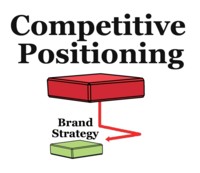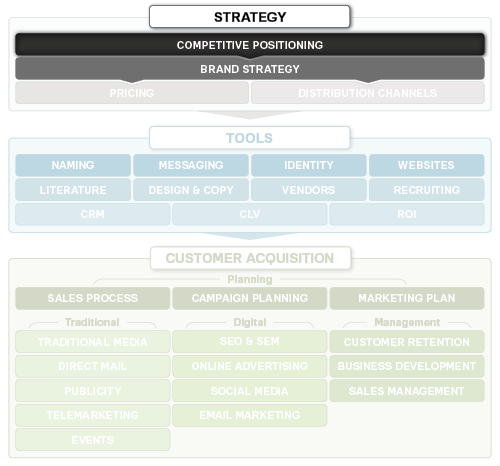Marketing Guides
Strategic Planning
Competitive Positioning
What sets your product, service and company apart from your competitors? What value do you provide and how is it different from the alternatives?
Competitive positioning is about defining how you’ll “differentiate” your offering and create value for your market. It’s about carving out a spot in the competitive landscape, putting your stake in the ground, and winning mindshare in the marketplace – being known for a certain “something.”
A good positioning strategy is influenced by:
- Market profile: Size, competitors, stage of growth
- Customer segments: Groups of prospects with similar wants & needs
- Competitive analysis: Strengths, weaknesses, opportunities and threats in the landscape
- Method for delivering value: How you deliver value to your market at the highest level
[Note: You can develop your competitive positioning and differentiate your brand using our comprehensive brand strategy toolkit — for step-by-step guidance while designing your brand strategy.]
When your market clearly sees how your offering is different from that of your competition, it’s easier to influence the market and win mindshare. Without brand differentiation, it takes more time and budget to entice the market to engage with you; as a result, many companies end up competing on price – a tough position to sustain over the long term.
One of the key elements that many small to mid-size companies overlook is how they provide value at the highest level. There are three essential methods for delivering value: operational excellence, product leadership and customer intimacy.
Here is a hypothetical example of each type of value.
| OPERATIONAL EXCELLENCE | PRODUCT LEADERSHIP | CUSTOMER INTIMACY |
|---|---|---|
|
Herringer customers don’t want bells and whistles; they just want a good product at the lowest possible price. Herringer focuses on operational excellence so they can continually offer the lowest price in the market. For example, they just patented a new machine that dramatically lowers their manufacturing costs. They’re not trying to create new or better products; they just want to produce more volume at a lower cost. Herringer’s method for delivering value is operational excellence; it’s a key driver of their long-term strategy, and their positioning reflects it. |
Orange Technology’s customers care most about quality – they want the best product. Orange is completely dedicated to innovation and quality. They’re constantly working on product improvements and new ideas to bring to market. They know what their competitors are doing and are completely focused on staying one step ahead in order to capture a greater share of their market. Orange’s brand and culture is all about product leadership; their market recognizes it and is willing to pay for it. |
Starboard’s market is flooded with products at all points of the price spectrum. Yet, Starboard’s customers want more than a product off the shelf; they want customized solutions. So Starboard’s strategy is to know as much as possible about their customers’ businesses so they can deliver the correct solutions over time. Starboard knows that they can’t just say “We offer great service.” Starboard delivers on their strategy in every interaction with their market. |
These companies have a complete understanding of how they deliver value to their market. It’s part of their strategy, which makes it easier for them to win a position in their respective markets.
Here’s another way to think of it:
You can provide the best offering, the cheapest offering, or the most comprehensive offering, but you can’t provide all three.
Another key factor in your brand positioning is your competition. Sure, you need to put your stake in the ground and claim your turf. But is it turf that you can own? Can you realistically beat your competition to own it?
Rather than leaving your market positioning to chance, establish a strategy. What you’re ultimately striving for is to be known for something – to own mindshare of the market. This is typically easier for consumer product lines than for B2B companies, because positioning a single product against three to five competitors is a simpler task than positioning a mid-size B2B company with numerous offerings in numerous markets.
Owning a strong position in the market is challenging for most small- to mid-size companies, but you have a better chance of achieving it if you clearly define a strategy and build your brand around it.
Do you see your company in any of these scenarios?
| Best Case | Neutral Case | Worst Case |
|---|---|---|
|
You provide a one-of-a-kind offering that your market needs and wants; you have strong differentiation from your competitors. Your market knows your name and associates it with that “one thing” that you’re known for. And you continually deliver on it – perception is reality – so you continue to win mindshare in your market, defending your turf and influencing your market. |
Your offering is somewhat different from – and better than – those of your competitors, and you communicate that difference (though probably not as consistently as you should). Some of your market knows your name, but they describe you in different ways; you’re not yet known for that “one thing,” but at least you’re occasionally recognized. You know that you could make a greater impact on your market with stronger positioning. |
Your market sees little difference between you and your competitors, and your name is not recognized. Because of this, you have to spend precious budget and time educating the market at each touch point. You often end up competing solely on price, though your business isn’t optimized to continue profitably with falling prices. You have to fight long and hard for every sale. It’s very difficult to meet your revenue and profit goals. |
Not Sure Where to Start with Competitive Positioning?
Access detailed step-by-step plans in our new marketing website.
It’s free to use
The concept of positioning is entirely strategic. It’s the first element to address in strategic marketing, and everything else is aligned to it. Jack Trout and Al Ries defined the concept years ago in their landmark book Positioning: The Battle for Your Mind.
While the concept is simple – to be known for a single thing in the mind of the customer – the road to achieve it can be complex. It’s best to have a clear understanding of your market – demographics, segments, their pains, how well you and your competitors provide solutions, how you truly provide value, and your strengths and weaknesses – before making this decision.
An fully-informed decision is vital, because you’ll allocate a significant amount of resources in your journey to achieve it.

Competitive Positioning Key Concepts & Steps
Before you begin
Your competitive positioning strategy is the foundation of your entire business – it’s the first thing you should pin down if you’re launching a new company or product. It’s also important when you’re expanding or looking for a new edge.
Profile your market
- Document the size of your market, and identify your major competitors and how they’re positioned.
- Determine whether your market is in the introductory, growth, mature, or declining stage of its life. This “lifecycle stage” affects your entire marketing strategy.
Segment your market
- Understand the problems that your market faces. Talk with prospects and customers, or conduct market research if you have the time, budget and opportunity. Uncover their true wants and needs – you’ll learn a great deal about what you can deliver to solve their problems and beat your competitors.
- Group your prospects into “segments” or “personas” that have similar problems and can use your offering in similar ways. By grouping prospects into segments or personas, you can efficiently market to each group.
Define how you deliver value
- At the highest level, there are three core types of value that a company can deliver: operational efficiency (the lowest price), product leadership (the best product), or customer intimacy (the best solution & service). Determine which one you’re best equipped to deliver; your decision is your method for delivering value.
Evaluate your competition
- List your competitors. Include any that can solve your customers’ problems, even if the competitors’ solutions are much different from yours – they’re still your competition.
- Rate yourself and your direct competitors based on operational efficiency (price), product leadership and customer intimacy. It’s easy to think you’re the best, so be as impartial as you can be.
Stake a position
- Identify areas where your competition is vulnerable.
- Determine whether you can focus on those vulnerable areas – they’re major opportunities.
- Make a decision on how to position your offering or company.
Select the mindshare you want to own, and record your strategy
- Review the components of your market and evaluate what you want to be known for in the future. Condense all your research and analysis into the “one thing” that you want to be known for, and design your long-term strategy to achieve it.
After Competitive Positioning
Once you have a competitive positioning strategy, develop a brand strategy to help you communicate your positioning and solidify your value every time you touch your market. Together, these two strategies are the essential building blocks for your business.
Check out our positioning and brand strategy toolkit if you’d like step-by-step guidance.
